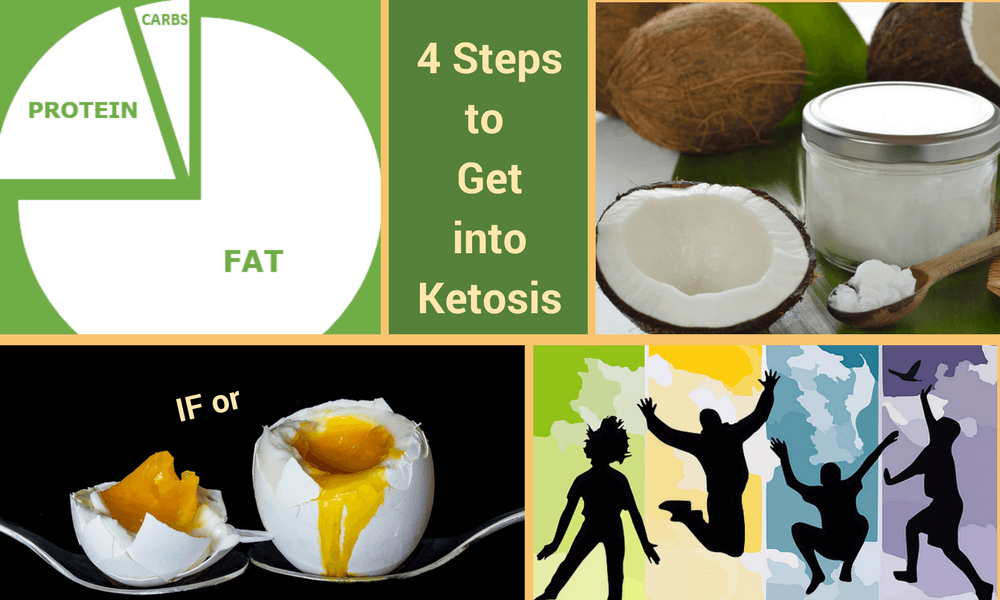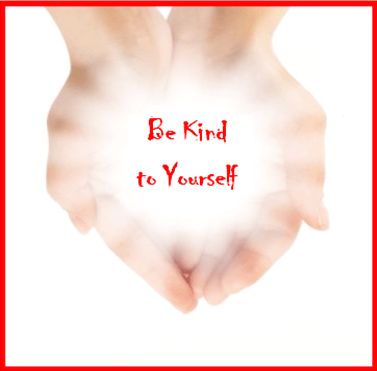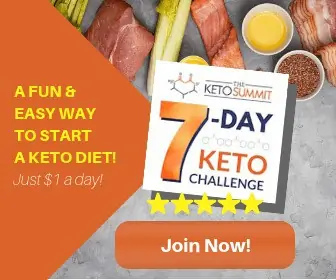How to Put Your Body in Ketosis
People who know how to put their bodies into ketosis will tell you that they do it in one of two ways...

They focus on minimizing carbs and upping fat. To that basic principle they may add exercise and intermittent fasting.
The second group will tell you they do all the above, but they focus very much on their macros, measure regularly and use supplements or exogenous ketones to ensure they get into ketosis fast and stay there.
For us, the most important factor is to change our fuel.
We then add external support with MCT oil, incorporate intermittent fasting and lastly we get moving.
Here is our 4 step process:
But:
Before we look at how, you may also be asking how long will it take.
If you are new to a ketogenic diet, it will take you anywhere from 2 days to two weeks.
Your body first needs to burn the glucose that are currently “hanging around” before it can change its fuel source to fat and ketones.
So how fast - will very much depend on:
Now then, let’s look at how to put your body into ketosis…
4 Steps to Get into Ketosis
You would have often heard me talk about changing your fuel from carbs to fat.
That is exactly what we do when we get into ketosis.
It is not tough to do, but requires diligence.
Here we go...
Step 1 - Change your Food (Fuel)
Cut the Carbs
Initially go as low as possible!
You want to consume less than 20 grams of net carbs when you start out.
Not sure what net carbs are? Then read more here.
When you don’t feed your body sugar or glucose, it will burn up all the available glucose and then it will start burning all the fat you eat and ultimately it will use body fat.
At this point you will be able to detect ketones in your blood and voila –
You are burning fat rather than sugar for fuel.
You may be one of those people who can get into and maintain ketosis even when you eat more carbs.
… but don’t even think about that when you start out.
Go low for at least two weeks and then you can start experimenting, with what you need to do, to maintain a comfortable level of ketosis.
One of the benefits of changing your fuel is that you'll lower the inflammation in your body.
Eat more Healthy Fats

Forget everything you have been told about fats being bad for you. Your body needs good healthy real fats and lots of it.
To get into ketosis, you are looking to increase your fat to at least 70% of your total calories and ideally to 75% of your total calories.
If you have been on the low fat bandwagon for a long time, I know this sounds counter intuitive, but give it a go...
To lose fat you need to eat fat.
When you eat fat, you’ll be less hungry and once your body is in ketosis, you’ll be surprised at how much less food you need.
Be however sure to eat good quality fats. No margarine or other man made “so-called” foods.
Good fats include avocado, grass fed butter, ghee, olive oil, coconut oil, butter and lard.
Eat enough,
but not too much Protein
Keto is not a high protein diet and if you eat too much protein, you’ll find that you struggle to get into ketosis or can’t stay there.
If you drop your protein intake too much, you risk losing muscle.
How much protein you need depends on your lifestyle.
If you live a sedentary life, you’ll need 0.7 to 0.8 gram of protein per pound of lean body mass.
The upper range for an active athlete is up to 1.2 grams.
So, you’ll have to find the ideal level for yourself within this range.
Revisit the keto diet rules, if you are not sure exactly what to eat or how to calculate your optimum protein level.
Limit your carbs to 20 net grams per day. This will lower your blood sugar and insulin levels, which will lead to the release of stored fatty acids that can be converted into ketones.
Eat enough good fat. It will boost your ketone levels and you won’t be hungry.
It is crucial to get the amount of protein right as too little may lead to the loss of muscle mass. Eating too much though will prevent you from reaching or staying in ketosis.
I sometimes feel like a broken record, but food has to be your starting point. There just is no other way.
Step 2 - Add Coconut or MCT Oil
The easiest way most of us add medium chain triglycerides (MCT) or coconut oil to our diets is through butter coffee.
We add butter and MCT oil to our morning brew. Watch here as the initial brain behind Bulletproof Coffee show you how and why.
If you are interested in adding MCT oil into your daily diet, then check out my preferred MCT oil.
If you don’t drink coffee add MCT oil into a morning smoothie, drizzle it over your salad or use it use with butter to make a sauce for vegetables.
If you are new to MCT oil, start slow as it can cause nausea, diarrhea or stomach cramping if you are not used to it. Start with a teaspoon and work your way up to 1 to 2 table spoons per day.
Why and how does coconut help to get your body into ketosis?
MCTs are rapidly absorbed and can be used immediately for energy or converted into ketones.
We all know that the ketogenic diet has been most successfully used for children with epilepsy. But to obtain the optimal results for epileptics, they have to substantially cut their carbs.
This can be hard to do...
But research has shown that by adding MCT oil into the children’s diets, ketosis can be induced without restricting carbs as drastically as with the classic ketogenic diet.
Step 3 - Try Fasting
There are two types of fasting that are useful for anybody following a ketogenic diet.
The first is a state of fasting to get “into it”.
The second is intermittent fasting which is a tool that can be used throughout life and many of us experience already between dinner and breakfast.
Start out with a 24 to 48 hour "get into it" Fast
Start out with a water or a fat fast to get into ketosis quickly.
When children suffer from severe seizures, they are often started out with a 24 to 48 hour fast to get into ketosis quickly and to get relief for their symptoms.
If it works for epilepsy patients, it follows that it should be helpful for any person trying to get into ketosis quickly.
Personally, I am not a big fan of “no food” fasting, but a fat fast for a few days can be very helpful to get into ketosis, to eliminate carb cravings and to control hunger.
Try a Fat Fast
There are many ways to do a fat fast. Most people do an egg fast. I find the idea of an egg fast somewhat revolting.
But the reality of a fat fast is not nearly as bad as it sounds.
If you are considering an egg fast, follow along with Megha and Matt from Keto Connect.
They share two videos with their experiences on a four day egg fast as well as the recipes they made whilst on the fast.
The rules of their fast was to eat:

They broke their fast on the night of day 4 and they both lost 2 pounds, which is high considering that they both have really low body fat.
Watch them start out here…
Make Intermittent Fasting part of your Life
If fasting feels a bit like a fad diet, then intermittent fasting may be more up your alley.
What is intermittent fasting (IF)?
It is a dietary approach that involves regular short term fasts.
This can be achieved by eating one or two meals per day and effectively fasting for the rest of the day.
Another way at looking at it is to eat all your meals during a window of 4 to 12 hours and therefore to be fasting for the other 12 to 20 hours per day.
Rather than daily intermittent fasting, it can also involve not eating at all for a day or two per week.
Intermittent fasting is sometimes the result of a keto diet, because once you learn to eat only when hungry you may very well start to eat in a narrower window.
Research studies are showing that IF can counteract disease processes as it relates to age related diseases.
It can improve insulin resistance, which can make it easier to get or stay in ketosis.
To learn more about intermittent fasting and the advantages thereof -
Fasting, both fat fasting and intermittent fasting, can support your efforts to get into ketosis relatively quickly.
Step 4 - Get Moving

When you get moving, you deplete your body’s glycogen stores, so being active can support your efforts to get into ketosis.
If you are not active at all, just get moving – walk, use the stairs, park further away from the store.
If you regularly exercise, then use your training to increase ketone levels.
Just be aware that you may find your energy levels lower when you try to get into ketosis. So slow down a little and work with your body.
Exercise before meals as exercising in a fasted state could increase ketone levels.
If you are not sure whether you should exercise on keto or not, then read my view on it and as always consult your doctor if you make major health changes.
Being active and moving can increase ketone levels when you restrict carbs and training before eating can enhance the effect.
How do I know?
Getting into ketosis is different for everybody, but following step 1 may be enough for most people.
If not, adopt steps 2 to 4.
But how do you know if you are in ketosis?
The simple answer is measure!
You can measure your blood ketone levels, your breath or your urine.
When you just start out, the easiest and cheapest way is to measure the ketone levels in your urine.
If you want to know more about urine test strips, please check out the review of Smackfat ketone strips...
If you find the desired ketone levels in your urine, carry on doing what you are doing.
If not, you are probably eating too much carbs or protein. You may want to control your macros more actively.
Read more about that here - What are Macros?
Need help? Then you may benefit from the seven day challenge created by the team at Keto Summit. Click on the image below to discover what it is about for yourself...
My Experience
My preferred method to get into ketosis is to follow the basic rules of keto (step 1).
I lower my carbs to 20 grams of net carbs per day, eat moderate amounts of protein and lots of fat.
I drink lots of water, eat more salt and add bone broth every day.
I only eat when I am hungry and manage ketosis flu symptoms as well as I can.
I don’t over think it and I don’t worry about every little thing I do.
Within the first few days I lose pounds of water weight. This I can see from the scale or in my body and face.
This for me is the first indication that there is enough change in my body to allow the release of excess water.
My focus is to give my body what it needs. After years of low fat starvation diets, it takes time to adjust and I believe I need to give my body time to learn to trust that the nutrition will not just be "pulled away".
Once my body gets that - enough fuel is available at any time, it has no reason to hang onto fat resources.
Once my body gets that enough fuel is available at any time, it has no reason to hang onto fat resources.
If you are insulin resistant like I was, then you may want to...
Read more about how carbs affect your insulin levels.
Personally when I want to get into ketosis, I don't exercise at all.
Exercise on a keto diet is a double edged sword. On the one side it helps to burn glucose left in the body, but on the other it can increase your cortisol levels.
I do however focus on moving more.
Whenever there is the impression that you may be starving, weight losing processes will slow down.
So this is a fine balance.
What About You?
Remember that you are unique and your experience may be different.
Absorb all these guidelines and then work out what works best for you.
The best way will be by experimenting and you may have to try more than one thing to find what works best for you.
Be patient and kind to yourself, but also know that with persistence you can enjoy the benefits that a keto lifestyle can bring to your life.


